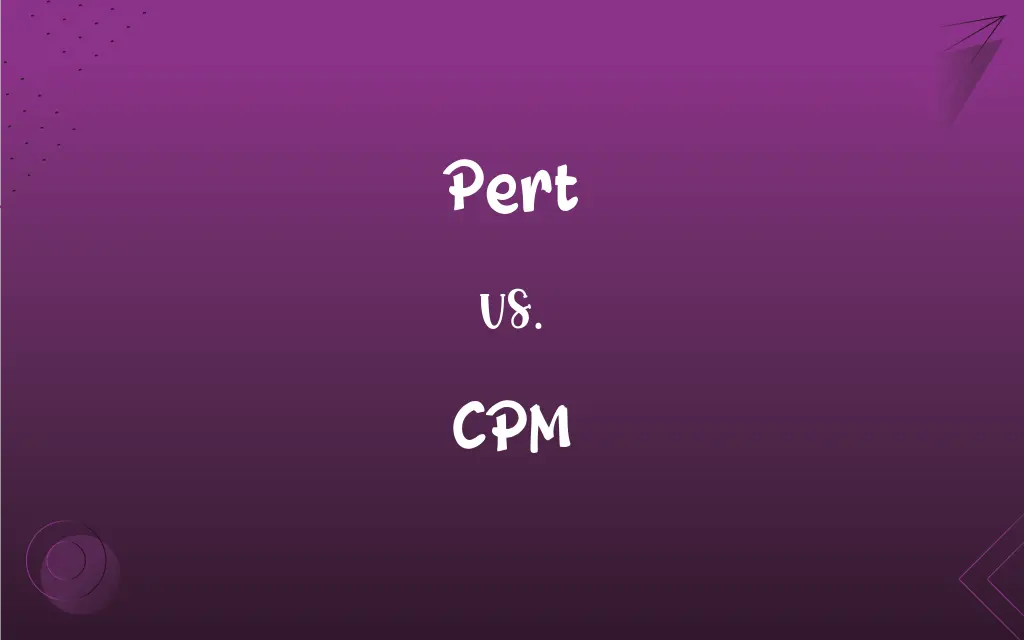PERT vs. CPM: What's the Difference?
Edited by Aimie Carlson || By Harlon Moss || Updated on October 14, 2023
Pert (Program Evaluation and Review Technique) and CPM (Critical Path Method) are project management tools; the former considers task variability and latter focuses on the critical path to minimize project duration and cost.

Key Differences
Pert (Program Evaluation and Review Technique) and CPM (Critical Path Method) are both methodologies used in the field of project management, each with its own unique attributes. Pert is a technique that is particularly used for projects for which the time needed to complete the various activities is not known with certainty. Consequently, Pert applies statistical methods to analyze the time needed to complete each activity in a project, employing three time estimates for each activity: the most optimistic time, the most pessimistic time, and the most likely time.
On the contrary, the Critical Path Method (CPM) concentrates predominantly on tasks and timelines. The CPM method sets a focus on the critical path in a project, which is the sequence of stages determining the minimum time needed for an operation. Consequently, CPM operates mainly with deterministic activity times, where the time required to complete each activity is known with certainty, and thus allows for straightforward scheduling and resource allocation for each task.
Notably, the application of Pert and CPM can be distinctly suitable in varying contexts. Pert has an edge when it comes to projects with a high degree of uncertainty in activity completion times, providing a probabilistic approach to understanding timelines. It thrives when managing projects where time predictions are uncertain and subject to variability, providing a structured, statistical model to account for this unpredictability and managing associated risks.
Contrastingly, the Critical Path Method (CPM) prospers when the timelines are known and definite. Given its deterministic approach, it can explicitly identify the critical path and, consequently, highlight which tasks can be delayed without delaying the project and which ones cannot. This makes CPM particularly useful for projects where time estimations can be made with a high degree of certainty, facilitating efficient resource allocation and timeline minimization.
In the grand context of project management, both Pert and CPM have pivotal roles contingent on the project's characteristics. Pert, with its probabilistic time estimates, assists in providing a statistical framework for projects shrouded with temporal uncertainty. Conversely, CPM, with its deterministic scheduling, serves excellently for projects where activity times are definite and a precise, optimal path needs to be elucidated for effective project completion.
ADVERTISEMENT
Comparison Chart
Nature of Time Estimation
Employs probabilistic time estimates (optimistic, pessimistic, most likely).
Utilizes deterministic time estimates.
Best Used for
Projects with uncertain activity times.
Projects with known and stable activity times.
Focus
Managing and mitigating uncertainties in project schedules.
Identifying the critical path to optimize project schedules.
Resource Allocation
Not primarily focused on resource allocation.
Resource allocation is often a key component.
Risk Management
Suited for projects with higher risk and variability in task duration.
Best for projects with lower risk and stable task duration.
ADVERTISEMENT
PERT and CPM Definitions
Pert
Pert emphasizes managing the unpredictability of project timelines through probabilistic approaches.
Considering the numerous unknowns, Pert was chosen to strategically guide the construction project.
CPM
In CPM, every project activity’s duration is deterministic and known with certainty.
With precise time estimates for each phase, CPM was employed to streamline the manufacturing process.
Pert
Pert is a project management technique that employs statistical methods to manage uncertain activity durations.
The project manager utilized Pert to navigate through the uncertain timelines of the software development project.
CPM
CPM aids in resource allocation along the project’s critical path, optimizing timelines.
Using CPM, the project leader allocated resources optimally, avoiding delays in crucial phases.
Pert
In Pert, activity durations are estimated using optimistic, pessimistic, and most likely times, acknowledging the variability.
The Pert method allowed for a structured approach, even when activity durations were uncertain.
CPM
CPM is pivotal for projects where timelines are definite, allowing for precise scheduling.
The certainty of task durations in the development cycle made CPM the preferred project management tool.
Pert
Pert often finds applications in projects where task durations cannot be estimated with high confidence due to its probabilistic nature.
The development team leaned on Pert to manage the variable timelines involved in innovative product creation.
CPM
CPM emphasizes identifying and managing the critical path to enhance project efficiency.
By focusing on the critical path using CPM, the team successfully navigated through the project’s pivotal tasks.
Pert
Pert aids in identifying, analyzing, and managing the time-related uncertainties within project tasks.
Through Pert, the team could foresee potential delays and plan for likely scenarios in the R&D project.
CPM
CPM is a project management approach that identifies the critical path to minimize project duration.
The construction manager utilized CPM to ensure the project adhered to its predetermined timeline.
Pert
High-spirited, lively, or cheerful
A pert receptionist greets each client.
Pert
Impudently bold; saucy
He was pert to his teacher. She gave a pert answer.
FAQs
What is the primary focus of CPM?
Identifying and managing the project's critical path.
How does Pert manage uncertain task durations?
By using optimistic, most likely, and pessimistic time estimates.
In which scenarios is Pert particularly useful?
Pert is useful in projects with considerable uncertainty in activity durations.
What does Pert stand for?
Program Evaluation and Review Technique.
Is resource allocation a key component of CPM?
Yes, CPM often involves detailed resource allocation and scheduling.
Is CPM suitable for projects with uncertain durations?
Typically no, CPM works best with certain and deterministic durations.
Which method is more straightforward to implement, Pert or CPM?
Typically, CPM is more straightforward due to its deterministic nature.
Is CPM effective for small-scale projects?
Yes, if the activity durations are known and stable, CPM can be beneficial.
Does CPM consider the variability in task durations?
No, CPM assumes that the task durations are known and constant.
Does CPM handle task dependencies?
Yes, CPM determines and manages task dependencies through the critical path.
Can Pert be used for projects with definite activity durations?
Yes, but it may not be as optimal as using a deterministic model like CPM.
Can CPM address probabilistic activity durations?
Not directly, as CPM is designed for deterministic activity durations.
Are Pert and CPM used exclusively in specific industries?
No, they are used across various industries wherever project management is involved.
Is software available for implementing CPM and Pert?
Yes, various project management software offers CPM and Pert modeling.
What are the main drawbacks of using Pert?
Pert might overcomplicate simple projects and can be resource-intensive.
Are there risk management benefits to using Pert?
Yes, Pert helps manage and mitigate risks related to activity duration variability.
What is a critical path in CPM?
It is the longest path through the project, dictating the shortest completion time.
What is a “network” in the context of Pert?
A network represents the project’s activities and the dependencies between them.
Can Pert and CPM be used together?
Yes, they can be integrated for managing projects with mixed characteristics.
How does Pert calculate expected activity duration?
Pert uses a weighted average of optimistic, most likely, and pessimistic times.
About Author
Written by
Harlon MossHarlon is a seasoned quality moderator and accomplished content writer for Difference Wiki. An alumnus of the prestigious University of California, he earned his degree in Computer Science. Leveraging his academic background, Harlon brings a meticulous and informed perspective to his work, ensuring content accuracy and excellence.
Edited by
Aimie CarlsonAimie Carlson, holding a master's degree in English literature, is a fervent English language enthusiast. She lends her writing talents to Difference Wiki, a prominent website that specializes in comparisons, offering readers insightful analyses that both captivate and inform.































































